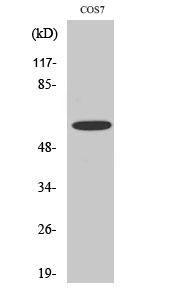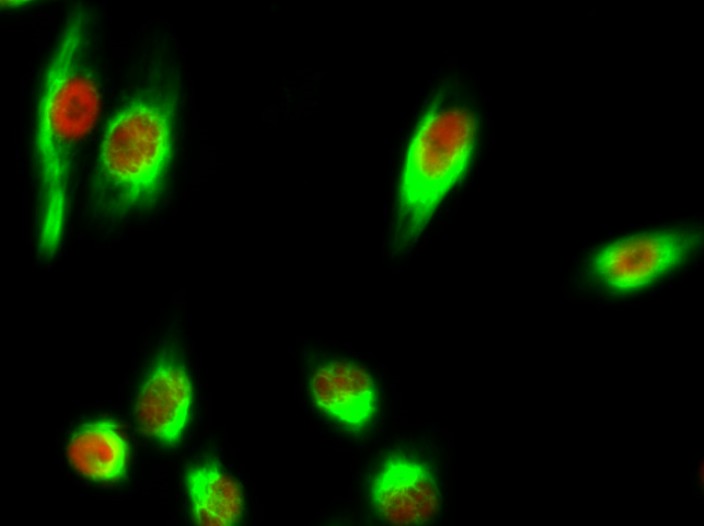Total Chk2 Cell-Based Colorimetric ELISA Kit
- Catalog No.:KA3073C
- Applications:ELISA
- Reactivity:Human;Mouse;Rat
- Gene Name:
- CHEK2
- Human Gene Id:
- 11200
- Human Swiss Prot No:
- O96017
- Mouse Swiss Prot No:
- Q9Z265
- Storage Stability:
- 2-8°C/6 months
- Other Name:
- Serine/threonine-protein kinase Chk2 (EC 2.7.11.1) (CHK2 checkpoint homolog) (Cds1 homolog) (Hucds1) (hCds1) (Checkpoint kinase 2)
- Detection Method:
- Colorimetric
- Background:
- catalytic activity:ATP + a protein = ADP + a phosphoprotein.,cofactor:Magnesium.,disease:Defects in CHEK2 are associated with Li-Fraumeni syndrome 2 (LFS2) [MIM:609265]; a highly penetrant familial cancer phenotype usually associated with inherited mutations in p53/TP53.,disease:Defects in CHEK2 are found in some patients with osteosarcoma (OSRC) [MIM:259500].,disease:Defects in CHEK2 are found in some patients with prostate cancer (CaP) [MIM:176807].,enzyme regulation:Rapidly phosphorylated on Thr-68 by MLTK in response to DNA damage and to replication block. Kinase activity is also up-regulated by autophosphorylation.,function:Regulates cell cycle checkpoints and apoptosis in response to DNA damage, particularly to DNA double-strand breaks. Inhibits CDC25C phosphatase by phosphorylation on 'Ser-216', preventing the entry into mitosis. May also play a role in meiosis. Regulates the TP53 tumor suppressor through phosphorylation at 'Thr-18' and 'Ser-20'.,similarity:Belongs to the protein kinase superfamily. CAMK Ser/Thr protein kinase family. CHK2 subfamily.,similarity:Contains 1 FHA domain.,similarity:Contains 1 protein kinase domain.,subcellular location:Isoform 10 is present throughout the cell.,tissue specificity:High expression is found in testis, spleen, colon and peripheral blood leukocytes. Low expression is found in other tissues.,
- Function:
- cell cycle checkpoint, DNA damage checkpoint, protein amino acid phosphorylation, phosphorus metabolic process,phosphate metabolic process, induction of apoptosis, response to DNA damage stimulus, cell cycle, intracellular signaling cascade, induction of apoptosis by intracellular signals, DNA damage response, signal transduction resulting in induction of apoptosis, regulation of cell death, positive regulation of cell death, induction of programmed cell death,phosphorylation, DNA integrity checkpoint, cellular response to stress, DNA damage response, signal transduction,regulation of apoptosis, positive regulation of apoptosis, regulation of programmed cell death, positive regulation of programmed cell death, regulation of cell cycle,
- Subcellular Location:
- [Isoform 2]: Nucleus. Isoform 10 is present throughout the cell.; [Isoform 4]: Nucleus.; [Isoform 7]: Nucleus.; [Isoform 9]: Nucleus.; [Isoform 12]: Nucleus.; Nucleus, PML body. Nucleus, nucleoplasm. Recruited into PML bodies together with TP53.
- Expression:
- High expression is found in testis, spleen, colon and peripheral blood leukocytes. Low expression is found in other tissues.
- June 19-2018
- WESTERN IMMUNOBLOTTING PROTOCOL
- June 19-2018
- IMMUNOHISTOCHEMISTRY-PARAFFIN PROTOCOL
- June 19-2018
- IMMUNOFLUORESCENCE PROTOCOL
- September 08-2020
- FLOW-CYTOMEYRT-PROTOCOL
- May 20-2022
- Cell-Based ELISA│解您多样本WB检测之困扰
- July 13-2018
- CELL-BASED-ELISA-PROTOCOL-FOR-ACETYL-PROTEIN
- July 13-2018
- CELL-BASED-ELISA-PROTOCOL-FOR-PHOSPHO-PROTEIN
- July 13-2018
- Antibody-FAQs


